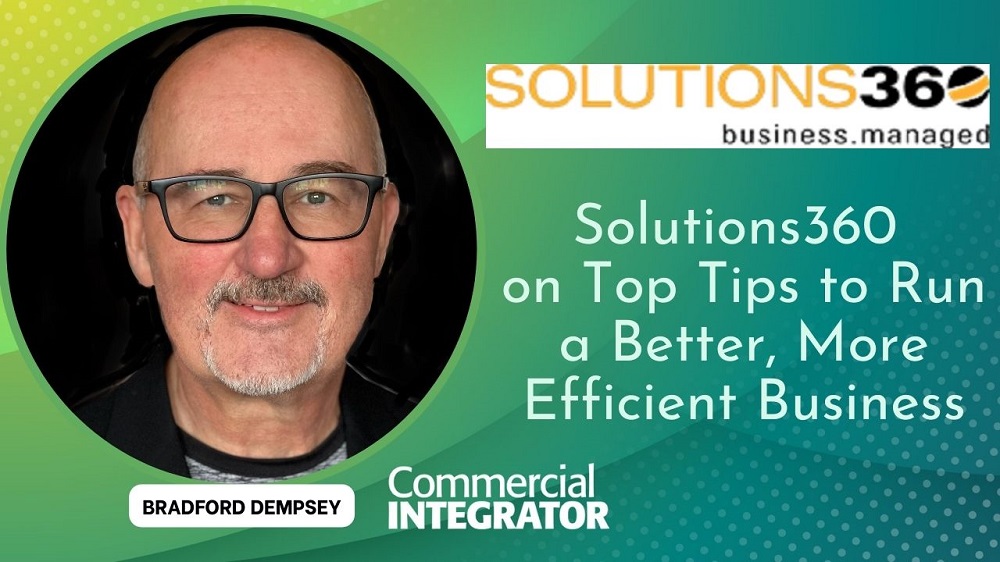Commercial Integrator chats with Bradford Dempsey, CEO and founder of Solutions360, on how integrators can step away from busywork and, instead, focus on maximizing their business effectiveness. He breaks down his top tips into one idea that takes days to implement, one idea that may take weeks to execute and one idea that may take months to fully bring to bear. It’s a conversation that no business owner can afford to miss hearing! Watch the full interview below and/or read the transcript below:
Commercial Integrator: What does it mean when we say integrators are so busy working in their business that they don’t have time to work on their business?
Bradford Dempsey: I first heard that term almost 40 years ago. I think it was introduced by a book called The E Myth, by Michael Gerber. And he talks about the concept of working on busy things in the business — basically, executing things. What he calls “falling into the role of the technician.” We’re just busy fixing things, as opposed to working on the business. We like to divide it into three areas: people, process and tools. What is the structure of the business? What’s the strategy? What’s the vision? What are the things that we can do which actually build a better and stronger business?
CI: What are some tips that integrators can leverage?
Dempsey: I’ll break it down into an idea that takes days to implement, one that may take weeks and one that may take months.
The first time we’re introduced to many integrators, one of the first things we see is that many of them are not valuing their labor correctly. We call this the labor burden or understanding how to price their labor. Let’s say a technician is making $25 an hour. Well, you can break that into the 2,080 hours a year that technician works, but then you have to add all the other things like taxes, healthcare, liability insurance and all those other things. Then, on top of that, that employee has a certain number of days during the year — especially when they’re salaried — where they’re getting paid, but they’re not actually producing revenue for the business. That’s paid time off, holidays, etc. So, right away, we’re cutting down that 2,080 hours down to about 1,800 hours.
Then, on top of that, we have something called utilization. It’s very important you look at how much of that time is being spent in revenue-generating opportunities for your business. That doesn’t mean you’re necessarily invoicing for every minute they’re working. They may be working on a service contract where you’re getting revenue from your customer. But the key is, they’re revenue generating. And good companies are quite often only in the 80% range for that utilization. What that basically means is that tech who’s making $25 an hour realistically is costing you closer to $50 an hour. So, item one is to really understand what your labor costs, and then use that when you’re rolling out your projects and you’re trying to figure out your profitability.
Another area where we see a lot of integrators burning up value is in pre-sales engineering. Now, as we know in the integration business, those engineers are some of the most skilled…some of the most expensive…resources we have. And when we deploy them to help us make sales, that’s a very important function. But how much does that really cost us? And what percentage of the value of that sale is eaten up with pre-sales engineering? And then, on top of that, are we rolling that pre-sales engineering cost into the overall profitability of our completed project, if we win it? And then, finally, if we’re not winning deals, how much of our engineering cost is going toward deals that we just didn’t win?
Finally, there’s estimating the way you deliver. That means taking everything from the building blocks we just talked about — understanding your true labor cost, understanding your pre-sales costs — and then building that into your estimating process so that the way you estimate…the way you break it down as far as material, labor, phases, WBS…maps out to the way you actually execute the work that you do. Because, if you do that, you get a feedback loop that allows you to estimate more accurately. And it’s not always about coming up with the lowest estimates; it’s about coming up with the most accurate estimates. So that, when you actually deliver your work, you’re not losing margin…you’re not losing profitability. And, quite often, it means you can estimate more competitively because you do truly understand your costs.
CI: How can people learn more about Solutions360?
Dempsey: Well, obviously, you can visit us at Solutions360.com. I’m on LinkedIn. And we also have a division called Navigate Management Consulting. It’s a company we acquired a couple of years ago. But Navigate has an academy — NavigateAcademy.net — and all NSCA members have free membership to Navigate Academy. So, I think that’s a great resource. We talk about all three of those areas: people, process and tools.

















